Tungsten
What is Tungsten
Tungsten (pronunciation TUNG-sten [2]), represented by the chemical symbol or formula W [1], is a hard, brittle element belonging to the family of transition metals [3]. Naturally occurring W is a mixture of 5 isotopes with mass numbers 180, 182, 183, 184 and 186 [1, 3]. Besides that, it has 33 synthetic, radioactive isotopes with known half-lives [3]. It doesn’t react with water and oxygen (air) at room temperature. In red hot condition, it forms its oxide. It reacts with halogens but remains unaffected by most acids and bases [9].
Where Is It Found
The metal does not occur freely in nature. Its principal ores are wolframite and scheelite. Commercially, it is produced by reducing tungsten oxide with carbon or hydrogen [1]. It is mined in China (world’s leading producer), Austria, Portugal and Bolivia [21].
History
Origin of Its Name: Its name is derived from the Swedish words “tung sten” meaning heavy stone [1]. The origin of its chemical symbol is its earlier German name, Wolfram that is derived from the mineral wolframite from which it was first extracted [2].
Who Discovered Tungsten: Spanish chemist brothers, Juan and Fausto Elhuyar [1, 2].
When Was It Discovered: Its discovery year is 1783 [1].
How Was It Discovered
In 1779, Irish chemist Peter Woulfe investigated a mineral from Sweden and concluded that it contained a new metal but did not isolate it. In 1781, German-Swedish chemist Wilhelm Scheele examined it and separated an acidic white oxide from it which he observed to be an oxide of a new metal. Finally, in 1783 the Elhuyar brothers successfully reduced the oxidze to metallic tungsten by heating it with carbon at the Seminary at Vergara, in Spain [1, 3].
Tungsten Identification |
|||
| Atomic Number | 74 [1] | ||
| CAS Number | 7440-33-7 [1] | ||
| Position in the periodic table | Group | Period | Block |
| 6 [1] | 6 [1] | d [1] | |
Properties and Characteristics of Tungsten
General Properties |
||
| Atomic mass | 183.84 atomic mass units [1] | |
| Atomic weight | 183.84 [1] | |
| Mass number | 184 [3] | |
| Molar mass/molecular weight | 183.84 g/mol [14] | |
Physical Properties |
||
| Color/appearance | Silvery-white [3] | |
| Luster | Metallic [3] | |
| Melting point/freezing point | 3414°C, 6177°F [1] | |
| Boiling point | 5555°C, 10031°F [1] | |
| Density | 19.3 g cm-3 [1] | |
| State of matter at room temperature (normal phase) | Solid [1] | |
| Thermal Conductivity | 164 W/(m K) [17] | |
| Electrical Conductivity | 18X106[1/ohm-m)] [17] | |
| Specific heat capacity | 0.134 J/g K [16] | |
| Specific gravity | 19.25 [18] | |
| Resistivity | 5.60X10-8 ohm-m [13] | |
| Hardness (Mohs scale) | 7.5 [27] | |
| Ductility | Limited/nil [19] | |
| Malleability | Yes [22] | |
| Yield strength | 550 MPa [24] | |
| Tensile strength | 100,000 – 500,000 psi [25] | |
| Temperature coefficient | 0.0045 [26] | |
Chemical Properties |
||
| Oxidation state/Oxidation number | −2, −1, +1, +2, +3, +4, +5, +6 [1] | |
| Flammability | Yes (W powder) [20] | |
Magnetic Properties |
||
| Magnetic ordering | Paramagnetic [11] | |
Atomic Data of Tungsten (Element 74)
| Valence electrons | 6 [4] | |||||||
| Valency | +2, +3, +4, +5, +6 [7] | |||||||
| Quantum numbers | ||||||||
| – n | 5 [5] | |||||||
| – ℓ | 2 [5] | |||||||
| – m ℓ | 1 [5] | |||||||
| – m s | +½ [5] | |||||||
| Electron configuration (noble gas configuration) | [Xe] 4f145d46s2 [1] | |||||||
| Crystal structure | Body-centered cubic [8] | |||||||
| Lattice constant | 316.52, 316.52, 316.52 pm [28] | |||||||
| Atomic structure | ||||||||
| – Number of Electrons | 74 [3] | |||||||
| – Number of Neutrons | 110 [3] | |||||||
| – Number of Protons | 74 [3] | |||||||
| Energy levels [3] | ||||||||
| – First Energy Level | 2 | |||||||
| – Second Energy Level | 8 | |||||||
| – Third Energy Level | 18 | |||||||
| – Fourth Energy Level | 32 | |||||||
| – Fifth Energy Level | 12 | |||||||
| – Sixth Energy Level | 2 | |||||||
| Radius of atom | ||||||||
| – Atomic Radius | 2.18 Å [1] | |||||||
| – Covalent Radius | 1.50 Å [1] | |||||||
| Electronegativity (Pauling scale) | 1.7 [1] | |||||||
| Ionization energy
(kJmol-1) [1] |
1st | 2nd | 3rd | 4th | 5th | 6th | 7th | 8th |
| 758.764 | 1553.4 | – | – | – | – | – | – | |
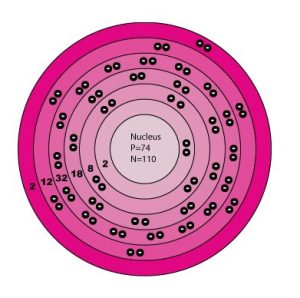
Tungsten Electron Configuration (Bohr Model)
Tungsten Uses
- As filaments in old style of incandescent electric bulbs. They are not much used these days as they are not energy efficient [1].
- It is alloyed with other metals or steel for strengthening them. The metal and its alloys have many high-temperature applications such as heating elements in high-temperature furnaces, arc-welding electrodes, etc [1].
- Tungsten carbide being massively hard is important to the mining, metal-working and petroleum industries. It also makes excellent drilling and cutting tools [1].
- Fluorescent lighting widely uses magnesium and calcium tungstates [1].
- Making jewelry and fishing equipment [12, 29].
Is It Dangerous
Though the element is considered to be of low toxicity to humans, inhaling hazardous W dust may lead to chronic poisoning that may result in pulmonary fibrosis [3, 10]. Exposure may also pose a risk of allergy [20].
Interesting Facts
- Tungsten is the metal which has the highest melting point [1].
- It is the strongest metal for its highest tensile strength [23].
- It does not rust, tarnish and is scratch resistant [15]!
Tungsten (W Element) Cost
The pure metal is priced at $11 for every 100 gram and in bulk, the same quantity costs $2.95 [3].
- References
- http://www.rsc.org/periodic-table/element/74/tungsten
- https://education.jlab.org/itselemental/ele074.html
- https://www.chemicool.com/elements/tungsten.html
- http://periodictable.com/Properties/A/Valence.al.html
- http://chemistry-reference.com/q_elements.asp?Symbol=W&language=en
- https://www.thoughtco.com/what-is-valence-or-valency-606459
- https://www.thoughtco.com/what-is-valence-or-valency-606459
- https://www.webelements.com/tungsten/crystal_structure.html
- Tungsten.com
- https://patient.info/doctor/tungsten-poisoning
- https://physics.stackexchange.com/questions/102463/is-it-possible-to-detect-fake-tungsten-aka-wolfram-gold-bars-with-a-strong-magne
- https://www.larsonjewelers.com/
- https://hypertextbook.com/facts/2004/DeannaStewart.shtml
- http://www.noblemind.com/search.exe?keyword=Tungsten+Molar+Mass&var=2
- https://www.overstock.com/guides/tungsten-rings-fact-sheet/
- http://hyperphysics.phy-astr.gsu.edu/hbase/Tables/sphtt.html
- https://www.plansee.com/en/materials/tungsten.html
- https://www.reade.com/reade-resources/reference-educational/reade-reference-chart-particle-property-briefings/25-specific-gravity-table-metals-minerals-ceramics-substance
- https://www.sciencedirect.com/science/article/pii/S0921509317312704
- nj.gov
- https://mineralseducationcoalition.org/elements/tungsten/
- https://study.com/academy/lesson/what-is-tungsten-definition-properties-uses.html
- https://www.linkedin.com/pulse/what-strongest-hardest-metals-mike-m-/
- http://www.goodfellow.com/E/Tungsten.html
- https://www.tungsten.com/materials/tungsten/
- http://hyperphysics.phy-astr.gsu.edu/hbase/Tables/rstiv.html
- https://www.jewelrynotes.com/the-mohs-scale-of-hardness-for-metals-why-it-is-important/
- http://periodictable.com/Properties/A/LatticeConstants.html
- https://www.tacklewarehouse.com/Tungsten_Bullet_Weights/catpage-TTTB.html
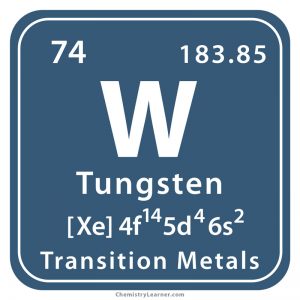
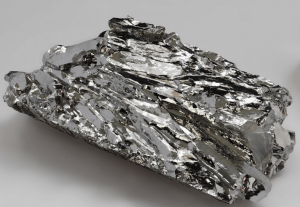

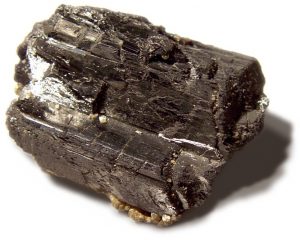
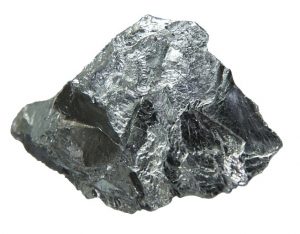
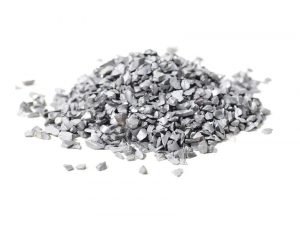





This page is intended for academic purpose. Unfortunately, there are some obscene ads in this page, which is very much embarrassing for the minor students. You should have applied your conscience in allowing such nasty ads in academic pages / sites.
We do not have any control over the ads.